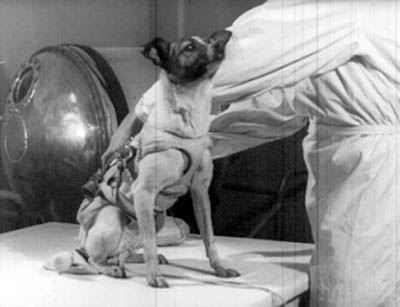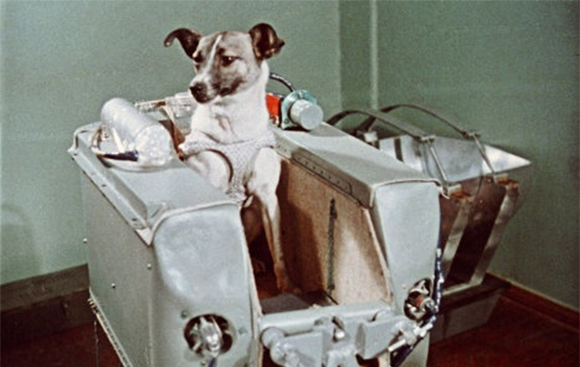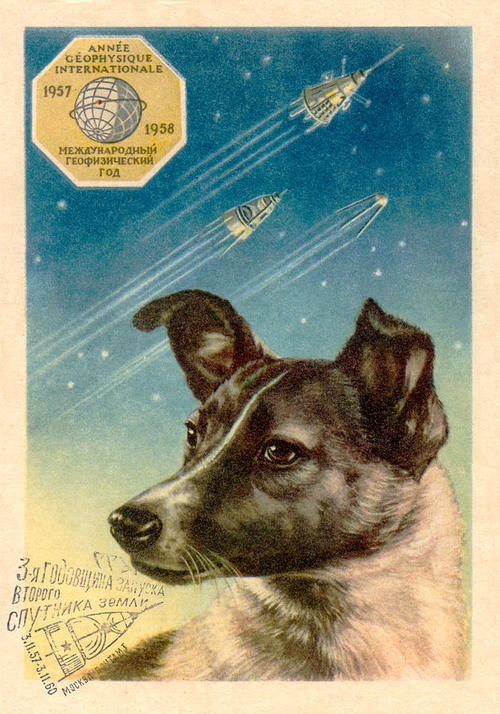Laika (c. 1954 – November 3, 1957) was a Soviet space dog who became one of the first animals in space, and the first animal to orbit the Earth.
Laika was a stray dog, originally named Kudryavka (Russian: Кудрявка Little Curly); she underwent training with two other dogs, and was eventually chosen as the occupant of the Soviet spacecraft Sputnik 2 that was launched into outer space on November 3, 1957, (becoming the first dog in space, to orbit the Earth, and was also the first animal to die in space.) The Soviets designed the spacecraft knowing she would not survive. One Soviet scientist took her home to play with his children because he said “I wanted to do something nice for her. She had so little time left to live.” Laika likely died within hours after launch from overheating, possibly caused by a failure of the central R-7 sustainer to separate from the payload. The true cause and time of her death was not made public until 2002; instead, it was widely reported that she died when her oxygen ran out on day six, or as Soviet government initially claimed, she was euthanized prior to oxygen depletion.
As a kid who was very into rockets and airplanes I remember being told about her (mind you, I wasn’t born until the cold war was ending), but in my childish innocence I assumed she came back okay.
Here’s a statement made by Oleg Gazenko, one of the Sputnik scientists:
“Work with animals is a source of suffering to all of us. We treat them like babies who cannot speak. The more time passes, the more I’m sorry about it. We shouldn’t have done it… We did not learn enough from this mission to justify the death of the dog.”
You know what makes me (sorta) happy? They built her a window. Despite the challenges and costs of building a secure window in a pressurized capsule, they did it so the dying dog could look out.
Source here:
Gazenko speaks of the bond that grew between the dog and him as they worked toward her mission, leading us in unembroidered prose through a brief tale of preparation, hours of readiness on the launch pad, and the launch itself. But the heart of the article for me, and the part to which nothing I’ve found since makes reference, is this: Gazenko tells us that as engineers rushed against deadlines to complete the capsule that would carry the dog into space, outfitting it with equipment to record the details of her death, he took on a battle in Laika’s behalf. Against heavy objections from the decision-makers, he insisted upon the installation of a window. A window in a space capsule, where such a luxury would cause complications and expenses that I can barely imagine. A window for the dog whose monitored demise had been this man’s objective in all the interactions that had bonded her to him with the eager devotion of every well-trained working canine.
Yet Gazenko persisted and prevailed.
Roof In Peace.
“Blackfish” is what happens when human arrogance trumps harsh natural reality.
Everyone needs to watch “Blackfish”, it’s a disturbing, revelatory film on the dangers of nabbing animals from their natural habitat and keeping them in captivity for our recreational purposes. Although a documentary, the film directed by Gabriela Cowperthwaite plays out like a razor sharp thriller on large smarmy entertainment corporations who abuse ethical boundaries and shoot animal rights to hell.
Blackfish chronicles Tilikum, an Orca who was captured in Iceland and brought to Seaworld, a popular American marine park to entertain audiences by performing tricks. To say that the film makes you loathe Seaworld is an understatement – it will make you cringe in your seat and sick to your stomach with its series of shocking exposes. Tilikum was treated like a milking commodity by the owners of the water park, and he ended up killing a few of his trainers in response. And appallingly, the Seaworld management not only refused to make changes to the way they do their business, but also blamed the victims for their own deaths.
All of that is just the tip of the iceberg and director Cowperthwaite puts together a bunch of searing interviews with former trainers and workers of marine parks who are now disillusioned and recount ghastly details of the underbelly of their industry. The filmmaker also interviews whale hunters who are absolutely disgusted with their own selves for being in a profession that slaughters other species. The details become more and more grim and disturbing as the film goes on, and you keep wondering why anyone would believe that putting killer whales in a tiny tank and making humans interact with them is a great business idea.
Seaworld refused to be interviewed for this film and the reasons are only too obvious. There is some horrific footage, least of which is when Tilikum grabs and drags his trainer to the bottom of the pool out of sheer frustration. If that doesn’t turn your stomach, the footage of hunters throwing a net and separating screaming baby whales from their mothers certainly will. It’s heartbreaking enough to crack open your home’s aquarium and set your pet fish free.
But this is not a sensationalist manipulative propaganda film. Apart from its substantial research work, Blackfish really rises to greatness for the way it makes a case against keeping killer whales in captivity by establishing the evidence that they are highly intelligent and emotional creatures. To date there are zero reported incidents of killer whales attacking humans in their habitat, and Tilikum was plucked from his family and home and placed in a tank that is the human equivalent of a bathtub to train. Three years ago the brilliant and unsettling The Cove exposed the annual mass torture and murder of dolphins in Japan, and Blackfish is a powerful companion piece to that film.




